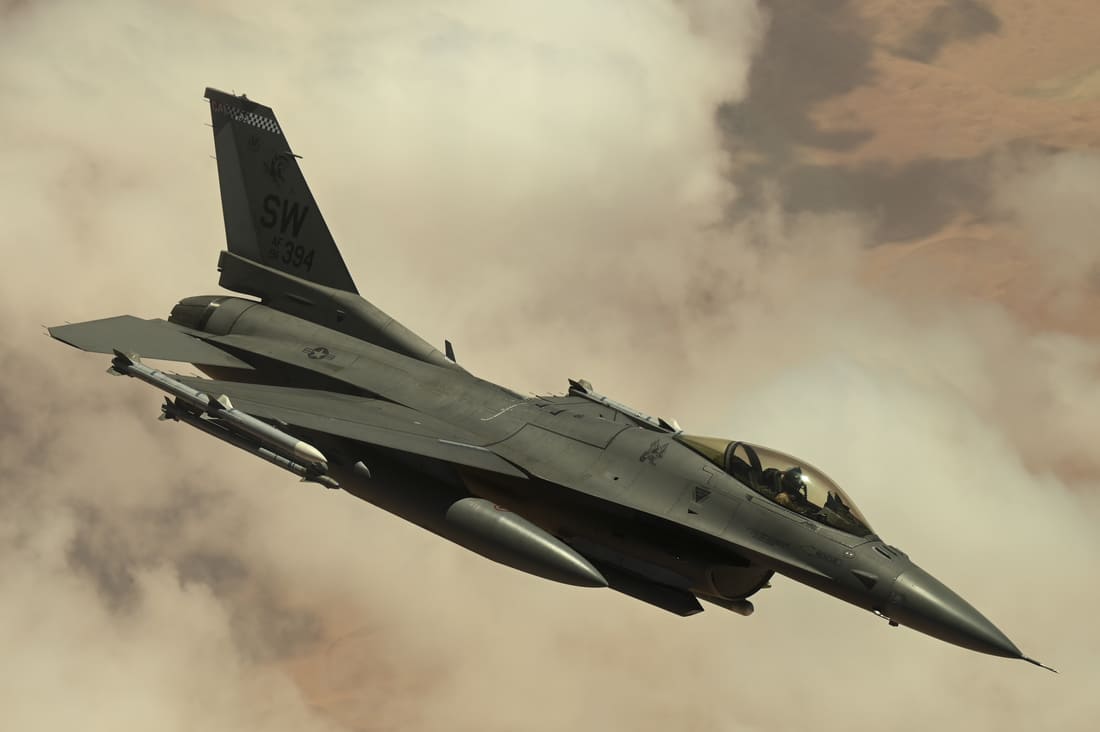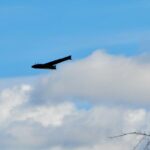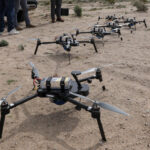The U.S. Air Force has awarded Red 6 a contract to integrate its Airborne Tactical Augmented Reality System (ATARS) on the F-16. The move takes cockpit-grade augmented reality out of trainers and places it in an operational fighter. Company and defense officials say work will start on two jets with flight integration scheduled to run over the next 12 to 18 months.
US Air Force F-16 augmented reality contract awarded via ACC and AFRL
Air Combat Command and the Air Force Research Laboratory issued the award after earlier ATARS tests on trainers and transports. The near-term goal is a clean F-16 integration, then a measured ramp to networked events that place multiple aircraft in one synthetic battlespace. Defense officials said the initial scope stays limited to two jets while integration matures.
Daniel Robinson, Red 6’s chief executive and a former Royal Air Force fighter pilot, cast the deal as the system’s first step onto the front line. “This is more than a contract – it’s a validation of our vision and a signal that the future of air combat training has arrived,” he said. He added the F-16 is “just the beginning.” Red 6 pitches ATARS as the only in-flight AR suite built to replicate the cognitive demands of real air combat while the pilot deals with real g-loads and cockpit workload no simulator can fully reproduce.
In a briefing, Robinson said the F-16 ranked high on Red 6’s target list due to its global footprint across U.S. and allied fleets. The first integration touches two aircraft on a 12 to 18-month schedule.
ATARS capabilities for F-16 training – helmet visor AR, virtual adversaries, multi-ship networking
ATARS centers on a helmet-mounted optical unit that projects full-color, high-resolution synthetic entities onto the pilot’s visor with low latency. A compact onboard computer and aircraft cabling tie the display into the jet. The system can render maneuvering adversary aircraft, missiles, surface threats, tankers, and friendly formations with correct size, closure, and aspect. Entities update in real time as the F-16 moves. Scenarios extend beyond simple “ghosts” in the sky and include cooperative elements such as unmanned wingmen for CCA training.
By design, ATARS runs across different helmets and platforms. That matters on the F-16, which carries diverse avionics baselines across blocks and operators. Red 6 markets the suite as network agnostic, able to ride different data pipes and still keep synthetic entities stable in the pilot’s view. The architecture also logs structured data to help squadrons grade performance and find weak points in decision making.
According to industry sources, the Air Force wants AR that scales beyond one-versus-one sets. A networked ATARS event can push many adversaries and friendlies into the airspace without burning extra sorties, fuel, or pilot hours on contracted red air. Robinson argues legacy red-air constructs risk negative training for the pilots cast as the bad guys and they rarely match the density or tactics of a modern fight. ATARS lets an F-16 flight work toward large-force problems while crews remain in their own cockpits.
Characteristics of the stack, as specified in the disclosure:
- Helmet-mounted optical module with a wide field of view. Visor projection of entities with high refresh and low latency.
- Fighter-sized computer, cabling, and interfaces. Software designed to mesh with existing comms and mission systems.
- Networking to support multi-ship events with synthetic friendlies and threats. Logs for post-sortie assessment.
Integration plan
Program officials mapped a crawl-walk-run sequence.
First, engineers validate interfaces on the ground and confirm ATARS plays cleanly with flight critical systems. Next, they fly single ship sorties to prove stability at G, at night, and across the envelope. Only then do they step to two ship sorties with shared synthetic airspace. The final phase brings complex vignettes – multiple adversaries, missile shots, off-board cues – and compares debrief data to planned behaviors.
Red 6 has already proved pieces of the stack in earlier programs. The Air Force funded integration on the T-38, where ATARS matured for formation training and basic fighter maneuvers. The suite also went aboard the MC-130 for special operations use cases and onto the RAF Hawk T2 during demo flights for frontline units.
The company links the F-16 work to broader partnerships. It teamed with Boeing on T-7A and has public collaborations with primes on trainer and autonomy efforts. None of these define the scope of the F-16 contract, they do hint at a path to scale if the Air Force moves to a program of record after first integration.
How ATARS saves red-air hours, records objective debrief data and supports manned-unmanned teaming
Live aggressor support costs money and time, and contracted red-air fleets cannot match the density of a large force package. ATARS trades some of that cost for software. It gives instructors the volume and variety they lack on normal lines, then produces data for debriefs without adding chase aircraft. The approach fits the Air Force’s interest in CCA, where crews learn to task and trust unmanned teammates. Synthetic wingmen inside ATARS let squadrons rehearse that workflow before the hardware enters units.
The company projects big savings if the combat Air Forces scale AR across fleets. Robinson has floated an estimate of about $10 billion over the five-year defense plan by trimming red-air and raising pilot throughput. The figure is a company claim not a budget line, and it signals how Red 6 will pitch return on investment to program offices. The Air Force will weigh those numbers against sustainment, flight safety and the cost to certify new avionics in a legacy fighter.
ATARS must align with other modernization tracks on the F-16. Units are already dealing with avionics refreshes, radar upgrades, electronic warfare work and structural mods. Any added gear competes for volume, cooling and electrical margin. Program managers will try to keep the footprint minimal – helmet optics on the pilot, a small computer in the bay, and cables along existing harness paths – so integration does not force extra downtime. The company markets the kit as “minimally intrusive” and “agnostic” to platform and helmet type which would help. Actual fit checks and the first few hundred flight hours will tell.
The F-16 flies with many partners. If the Air Force proves a baseline install and training syllabus, other operators could adopt the same package or a tailored set for their own fleets and ranges. According to industry sources, allied interest tracks with the F-16’s share of global fighter inventories, though export timelines would follow national airworthiness and security processes.
Red 6’s previous work hints at day to day use. A four-ship can stage a local sortie with a layered threat – push timings, pop-up missiles and a high-end adversary type – then grade the run from the recorded dataset without waiting for contractor jets or another squadron to play bad guy. Instructors can dial up complexity in software, switch adversary types and inject failures to stress task saturation. The flexibility supports a push to put more reps into fewer hours while keeping flight-line safety margins.
The editorial team at Defense-Aerospace asked about long-term training. Our analysis shows three pivots if integration holds. First, more frequent, higher-density air-to-air reps for F-16 units. Second, an earlier, smoother path to manned-unmanned teaming syllabi for CCA. Third, better debrief tools drawn from structured datasets rather than memory-based reconstructions. None of this replaces live adversary work at large exercises, but it can offload routine pieces that consume time and fuel.
Robinson, who flew the F-22 on an exchange tour and trained on the Tornado F3, argues AR must live where pilots fight – in the jet, under G, with limited time to think. The F-16 effort gives that thesis a hard test across many blocks and missions. If results match the pitch, the Air Force gains a tool it can repeat across other types without buying fleets of new aggressors. If not, AR may stay a niche add-on for trainers and special roles. Either way, this contract turns an idea into a program with dates, aircraft and sorties to measure.
REFERENCE SOURCES
- https://www.shephardmedia.com/news/air-warfare/usaf-to-use-augmented-reality-technology-in-f-16-cockpit/
- https://breakingdefense.com/2025/08/red-6-wins-deal-to-bring-augmented-reality-to-f-16s/
- https://www.prnewswire.com/news-releases/red-6-secures-us-air-force-contract-to-revolutionize-f-16-pilot-training-with-world-first-augmented-reality-training-system-302530837.html
- https://www.flightglobal.com/fixed-wing/us-air-force-to-add-red-6-augmented-reality-tech-into-f-16-cockpits/164171.article
- https://theaviationist.com/2025/08/18/red-6s-atars-integrated-f-16-training/
- https://thedefensepost.com/2025/08/26/usaf-red6-atars-f16/



